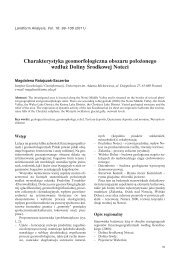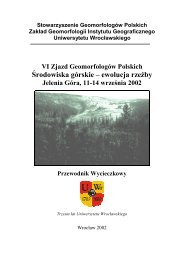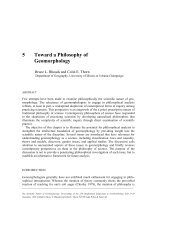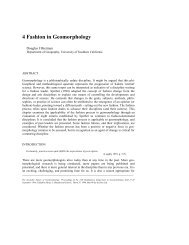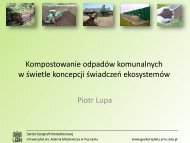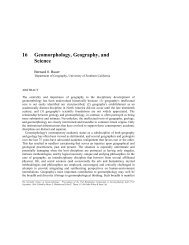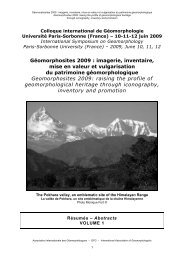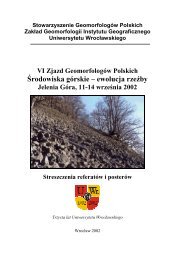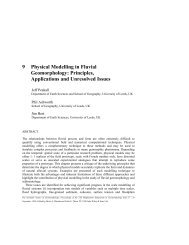Chapter 16 - Geomorphology, Geography, and Science Bernard 0
Chapter 16 - Geomorphology, Geography, and Science Bernard 0
Chapter 16 - Geomorphology, Geography, and Science Bernard 0
You also want an ePaper? Increase the reach of your titles
YUMPU automatically turns print PDFs into web optimized ePapers that Google loves.
GEOMORPHOLOGY, GEOGRAPHY, AND SCIENCE 395<br />
In retrospect, it seems that these two presidential addresses, although altruistic in intent,<br />
did much violence to the image of the geographer-geomorphologist. The perceived<br />
weakness of the historical linkages between geography <strong>and</strong> geomorphology became<br />
officially entrenched in the literature through their musings. Fortunately, some of the more<br />
significant advances in twentieth century geomorphological thought were coming not<br />
from retrospective introspection about the prescribed subject matter of geography or<br />
geology, but from sources that were completely unaware of or impartial to such inter- <strong>and</strong><br />
intra-disciplinary reconditioning. Strahler (1950, 1952) is to be acknowledged for warning<br />
the geomorphological community that much of the relevant <strong>and</strong> substantive research on<br />
erosional <strong>and</strong> dynamical systems was being conducted by engineers, <strong>and</strong> that '... few<br />
geologists seem aware of this progress <strong>and</strong> there has been little evidence of<br />
geomorphologists adapting the information <strong>and</strong> methods to l<strong>and</strong>form research' (Strahler<br />
1950, p. 211). Useful innovations were coming not only from engineering, but also from<br />
hydraulics, biological systems, hydrology, thermodynamics, <strong>and</strong> statistical mathematics.<br />
The course of developments since the 1950s should be familiar to most geomorphologists,<br />
<strong>and</strong> it includes phrases <strong>and</strong> concepts such as tectonic <strong>and</strong> isostatic uplift, timebound <strong>and</strong><br />
timeless models, reductionism, morphometric analysis, mechanics <strong>and</strong> dynamics,<br />
hydraulic geometry, magnitude <strong>and</strong> frequency, systems theory, allometry, equifinality,<br />
entropy, indeterminacy, equilibrium <strong>and</strong> thresholds, characteristic forms, process-response<br />
suites, <strong>and</strong> numerical modeling. It is also appropriate to acknowledge the advanced <strong>and</strong><br />
insightful works of researchers such as O'Brien, Hjulstrom, Rubey, Shields, Bagnold,<br />
Leighly, Sundborg, <strong>and</strong> Yatsu who were somewhat peripheral to the mainstream of<br />
geomorphology of their time. Bagnold, for example, is now widely acknowledged for his<br />
exploration of the North African deserts <strong>and</strong> for his many contributions to our<br />
underst<strong>and</strong>ing of the nature of aeolian dune systems <strong>and</strong> the mechanics of sediment<br />
transport. His academic contributions span a period of almost six decades, beginning with<br />
the publication of many seminal works in the 1930s <strong>and</strong> 1940s, after having retired from a<br />
distinguished army career! The Royal Geographical Society of London awarded him the<br />
Gold Medal in 1934, the US Academy of <strong>Science</strong>s awarded him the G. K. Warren Prize in<br />
1969, whereas the Geological Society of America waited until 1970 to honor him with its<br />
Penrose Medal. These awards were followed by the Wollaston Medal from the Geological<br />
Society of London in 1971 <strong>and</strong> the Sorby Medal from the International Association of<br />
Sedimentologists in 1978. The geomorphological community, on the other h<strong>and</strong>, failed to<br />
recognize Bagnold's achievements officially until 1981, at which time he was awarded the<br />
David Linton Award from the British Geomorphological Research Group.<br />
The evolution of geomorphology during this period was affected not only by<br />
intradisciplinary debates within geography <strong>and</strong> geology, but also by social, political, <strong>and</strong><br />
economic climates - that is, the 'internal' <strong>and</strong> 'external' histories (e.g. Livingstone 1984, p.<br />
27 1; Yatsu 1992, p. 94). The latter tend to facilitate or hamper developments in certain<br />
disciplines both directly <strong>and</strong> indirectly. The opportunities afforded geology by the boom in<br />
petroleum <strong>and</strong> mineral exploration in the 1960s <strong>and</strong> 1970s, for example, eventually<br />
steered geological interests away from geomorphological subject matter. In a 1971 survey<br />
of geomorphological offerings in North American geology departments, White <strong>and</strong><br />
Malcolm (1972, p. 146) warned that



